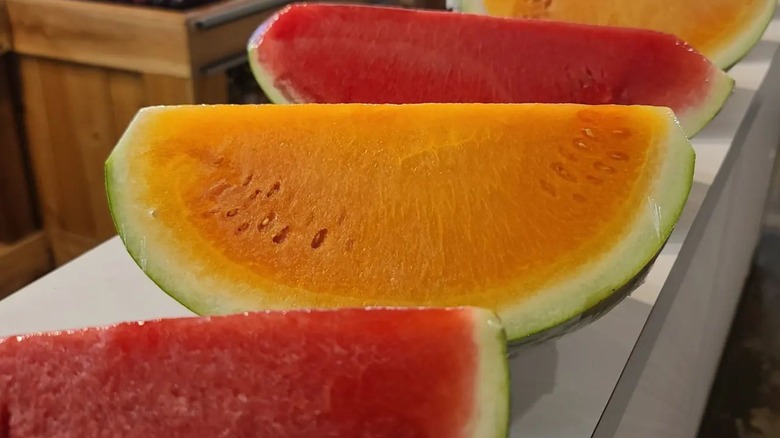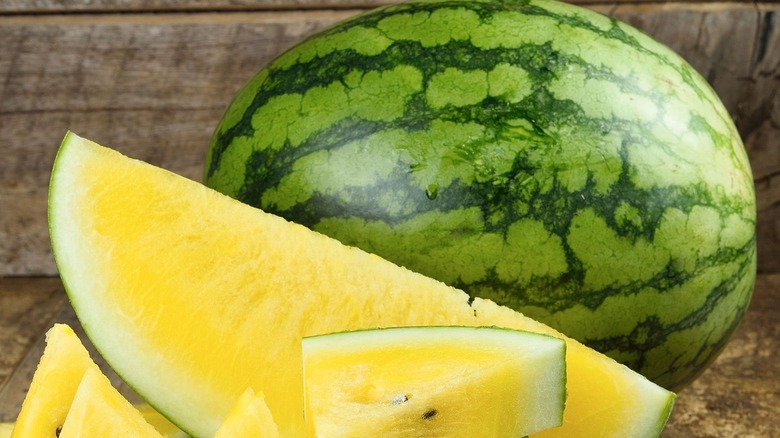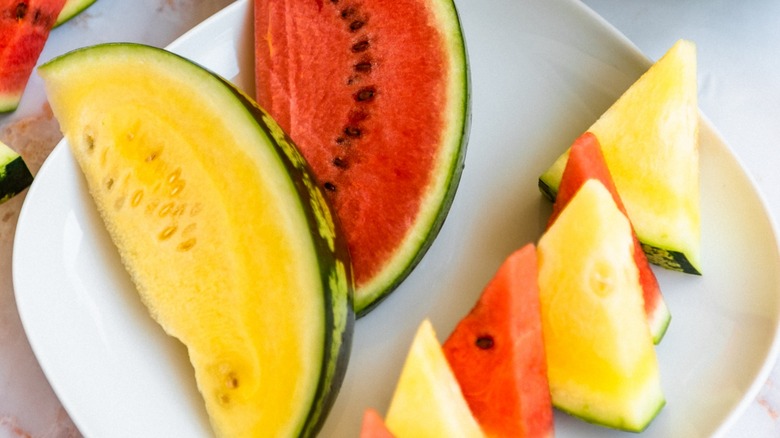The Tasty Difference In Orange Vs. Red Watermelon
Watermelons have a distinct look — their light and dark green stripes give way to a deep red-pink hue when they're cut open. They just look refreshing, as if Mother Nature wants us to enjoy a sweet slice of watermelon on a warm summer day. However, this is far from the only way watermelon can appear in the wild. Just like many other crops, the variety of watermelon found in common supermarkets is just one of many different cultivars. Out of this entire genetic pool, orange and yellow watermelons stand out as being the most visually — and deliciously — striking.
Orange watermelons have more of a honeyed taste than their red counterparts, though the level of sweetness seems to depend on the specific type of melon. That's right: Orange watermelons aren't just one single cultivar. For example, the Tendersweet Orange Watermelon has a mild sweetness while the Orangeglo variety is sweeter and has more of a distinctly "tropical" taste, according to those who have sampled. The same goes for yellow watermelons, in which case the seedless Buttercup Yellow reigns supreme for sweetness due to its higher levels of sugar.
Why are orange watermelons orange?
Orange and yellow watermelons actually get their distinct color due to a lack of an element found in their red cousins, not because of any sort of additive. This element is lycopene — a pigment that colors common watermelons as well as all sorts of other produce such as tomatoes, grapefruits, and red bell peppers. This is also why watermelons as they existed in their original forms were probably closer to a yellow color, as evidenced by a Byzantine mosaic from present-day Israel dating to about 425 C.E.
In a fascinating bit of botanist history, these progenitors of the modern watermelon were probably not as sweet as their descendants, and people learned how to cultivate the red varieties due to their succulency. Today, red watermelons exist in the mainstream while yellow and orange watermelons are only grown by and sold through specialty farmers and suppliers. Luckily, however, they're far from extinct.
How to find and use orange watermelons
You can sometimes spot orange watermelons at your local farmers' market during the summer. You can also use online resources like Instacart and Safeway to order them through third-party supermarket suppliers or check if they're being sold somewhere in your area. The most likely place you'll be able to find yellow watermelons on happenstance is in Trader Joe's, which has been known to stock the fruit when it's in season.
Despite their stark visual contrasts, you can prepare all colors of watermelon the same way. Mixing red, orange, and yellow slices together in a fruit salad is an aesthetically gorgeous way of sampling the subtle taste differences between them. You can also blend them up into a smoothie, scoop them into balls, or use them to add sweetness to a savory salad. Both yellow and orange watermelons are nicely tossed with herbs like basil, parsley, and cilantro, nuts like walnuts and pine nuts, and cheeses like goat cheese and mozzarella. Watermelon season ends in early fall, so it behooves you to get your hands on some of these different varieties of the iconic fruit during the summer for a juicy finale to the warm months.



